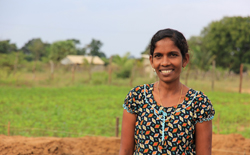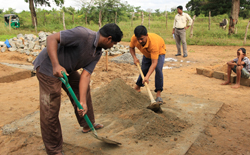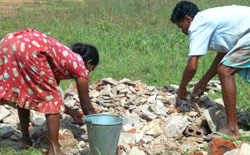
UN-Habitat, one of the Implementing Agencies under the Indian Housing Project, is promoting eco-friendly construction techniques for homeowners in Sri Lanka's conflict affected Northern Province as well as assisting with the reduction of construction costs with improved house designs. These eco friendly model houses are being constructed with the aim of educating homeowners and encouraging smarter building practices.
Following the end of three decades of conflict and the subsequent resettlement of Internally Displaced Persons (IDPs) in their villages of origin, construction activities have significantly increased in the Northern Province. This has lead to increasing demand on construction materials including sand and traditional timber varieties. The dearth of building materials has also resulted in escalating costs in the North. Recognising the urgent need to ensure the adequate supply of building materials whilst safeguarding the fragile environment in the North, UN-Habitat is promoting an initiative to construct "eco-friendly model houses".
Mrs. K. Vasuki from Karachchi DS division in Killinochchi district and Mr. Thangarasa Sivakathir from Odusuddan DS division in Mullaitivu district are two home owners selected to reconstruct their damaged houses under the Indian Housing Project. Both houses are being constructed as model houses.
39 year old Vasuki is a single mother with five children as she has been separated from her husband for several years. She earns a living by packaging tea and spices at home. 31 year old Thangarasa works as an unskilled labourer earning approx. 700 LKR per day whenever work is available. His wife Sripriya is 27 years old and they have a 5 year old son. Both families are currently living in temporary, makeshift shelters constructed of tin sheets.

The UN-Habitat field team has assisted both families to select suitable house plans and provided advice on construction work and building materials. As the project follows a "home owner driven" method of construction, Vasuki and Thangarasa are responsible for the planning, organization and construction of their houses. Both families have been providing their unskilled labour towards the construction process including clearing the land and digging trenches for the foundations and sourcing building materials. Skilled craftsmen have been hired to undertake the major construction work.

The model houses have modern layouts, keeping to the minimum floor area requirements specified by the project. The traditional court yard concept has been modified to adapt to the reduced floor area to improve natural light and ventilation. Thermal comfort is improved from the cross ventilation and new building materials, and trees will be planted to increase shading. The design also allows for future expansion of the house to promote incremental development. Beneficiaries are being trained to practice some of the technologies through practical training programmes at the site which will improve their vocational skills and livelihood opportunities.
The walls of both model houses are being constructed out of cement stabilized earth bricks (CSEB) in place of traditional cement blocks or bricks. CSEB walls are a cost effective and environmental friendly method of house construction. Properly built CSEB walls need no plaster and consume less cement mortar for bonding, thereby reducing sand and cement consumption significantly. These blocks can be produced by beneficiaries themselves, using suitable earth, with a simple manually operated machine. These bricks can also be purchased from the market, in the form of inter-locking bricks and lintel bricks. The houses constructed with stabilised earth bricks are much cooler than houses constructed with other bricks or cement blocks as the soil has a superior cooling effect.
UN-Habitat is promoting other low cost, eco- friendly technologies such as fair faced masonry, earth plaster and earth based wall paint for plastering. These methods are relatively low in cost compared to using traditional plastering methods with lime and cement. Earth based paints will be used to paint the walls by mixing earth with cement and a binder material.

The homeowners will also use treated plantation timber species such as Rubber and Pinus for door and window construction. The treated timbers will be durable and therefore more cost effective in the long run and will not lead to loss of forest cover in the North as these are sourced from plantation forests.
In addition to using alterative building materials, home owners are also practising innovative methods to minimise wastage and construction costs. These methods include using salvaged building materials such as small recycled hard debris for foundations, as well as previously used unbroken tiles and roof timber for roofs. Concrete, tile and brick parts converted to course aggregates of concrete are being used for paving. Beneficiaries have also been trained on correct storage methods of building materials such as sand and cement, thereby eliminating excessive wastage.

Each model house will have a domestic rainwater harvesting unit installed for roof top rainwater collection, ensuring improved access to water during the dry season. Smoke free chimneys and domestic bio gas production units will also be installed in each house. The biogas chamber will be used for biogas production with domestic waste for cooking.
Discussing the construction of her house, Vasuki stated: "I thank the Indian Government for providing this opportunity and UN-Habitat for all the advice and support they are providing in constructing this house using new techniques and materials. We have been able to select cost effective building materials and make savings on overall cost after participating in the UN Habitat awareness programme."
The Indian Housing Project (IHP) is a housing reconstruction project funded by the Government of India and implemented through a Memorandum of Understanding with the Government of Sri Lanka. Four Implementing Agencies (IAs) are executing this project in the Northern and Eastern Provinces of Sri Lanka. UN-Habitat is one of the IAs working in the Northern districts of Killinochchi, Mullaitivu and Jaffna. The 36 month project will be implemented from 2012 to 2015 and will follow a home owner driven process. During this period, UN-Habitat will support 16,800 families to reconstruct or repair their homes.
UN-Habitat is currently implementing several housing reconstruction projects in the North and East of Sri Lanka with funding from the European Union, Government of India, Australian Government and the Swiss Agency for Development and Cooperation. 10,000 houses have been built during the past three years and over 20,000 houses will be reconstructed or repaired over the next three years under these programs.
- UN-Habitat Completes 12,500 Houses under Government of India's Grant Assistance
- Self-lighting Solar Lamp for Thiruvaiyaru Community Centre in Kilinochchi District (PDF 252KB)
- Introducing environmentally friendly construction techniques for post-conflict housing and community infrastructure (PDF 382KB)
- Empowering Women to Rebuild Homes in the Conflict Affected Northern Province (PDF 634KB)
- UN-Habitat Helps Families to Construct Environmentally-Friendly Houses in the North of Sri Lanka (PDF 609KB)
- Empowering Female Headed Homeowners to Reconstruct their Damaged Homes (PDF 789KB)
- Building Blocks for a Brighter Tomorrow (PDF 395KB)
- A New Beginning for Returnee Families in the North of Sri Lanka (PDF 424KB)
- Workshop on Incremental Housing (PDF 152KB)
- Government of Australia Supports Mannar Urban Council to Mitigate the Risk of Sea Water Intrusion in a Vulnerable Coastal Village (PDF 286KB)
- A Permanent Home for a Young Family in Killinochchi District (PDF 555KB)
- European Union Delegation Visits UN-Habitat Housing Beneficiaries in Batticaloa District, Sri Lanka. (PDF 205KB)
- UN-Habitat Provides Training on Innovative Construction Techniques for Artisans and CBO Members from Mannar District (PDF 167KB)
- UN-Habitat Implements Disaster Risk Reduction Initiatives in Mannar Town in Sri Lanka’s Northern Province (PDF 393KB)
- Training on Geographic Information Systems for Disaster Resilient Urban Planning for Local Authority Officers and Urban Planners (PDF 248KB)
- Disaster Risk Reduction through River Rehabilitation in the Heart of Flood-Prone Balangoda Town (PDF 287KB)
- Case Study: Improving Accessibility through Rehabilitating Internal Roads in the North (PDF 677KB)
- Case Study: Helping Communities Rebuild in Post-Conflict Killinochchi District (PDF 713KB)
- Case Study: Building Hope for the Future: Rebuilding Preschools in Sri Lanka’s Conflict Affected Northern Province (PDF 695KB)
- Rebuilding Homes in Conflict Affected Mullaitivu District (PDF 500KB)
- International Conference on Post Emergency Shelter Reconstruction held in Colombo, Sri Lanka
- Video Documentary: Indian Housing Project: Rebuilding Homes in the North and East of Sri Lanka
- Reconstructing Conflict Damaged Homes in the East of Sri Lanka (PDF 228KB)
- The Government of Australia Supports Disaster Risk Reduction Initiatives in Kalmunai Town, in Partnership with UN-Habitat (PDF 410KB)
- Training Programme on Integrating Disaster Risk Reduction into Urban Planning and Development for Planning Officials in the North and East of Sri Lanka
- Reviving His Livelihood in a New Home (PDF 299KB)
- Empowering Female Home Owners to Repair Damaged Homes in the North (PDF 262KB)
- Helping Returnee Families in the North with Sanitation Facilities
- Case Study: Empowering Female Home Owners to Reconstruct Houses in Northern Sri Lanka (PDF 225KB)
- A New Beginning for a Young Family (PDF 266KB)
- Case Study: Rebuilding His Own Home: Sivakanthan of Mullaitivu District (PDF 295KB)
- Flood Risk Reduction Pilot Project Completed in Kalmunai Town with Australian Funding
- Eco-friendly home construction for returnees in Northern Sri Lanka
- European Union Launches Housing Project for Returnee Families in Batticaloa District
- Case Study: Stories from the Field: Vallipuram Elumalaipillai, Malayalapuram, Killinochchi District, Northern Sri Lanka (PDF 295KB)
- Toolkit on School and Hospital Building Safety in South Asia
- Case Study: From Temporary Hut to Permanent Home (PDF 160KB)
- Case Study: Stories from the Field: Nalathamby Kanahasooriyan, Hijrapuram, Mullaitivu district, Northern Sri Lanka (PDF 262KB)
- World Habitat Day 2012
- Shelter Support to Conflict-affected IDPs in the North of Sri Lanka: Case Study 1 (PDF 233KB)
- Shelter Support to Conflict-affected IDPs in the North of Sri Lanka: Case Study 2 (PDF 332KB)
- Shelter Support to Conflict-affected IDPs in the North of Sri Lanka: Case Study 3 (PDF 238KB)
- Shelter Support to Conflict-affected IDPs in the North of Sri Lanka: Case Study 4 (PDF 233KB)
- Reconstruction of Three Thousand War Damaged Houses Under Way in Northern Sri Lanka with Funding from the European Union, the Australian Government, the Swiss Agency for Development Cooperation
- Nordic funding to Enhance Resilience to Climate Change in Coastal Sri Lankan Cities
- A National Climate Change Policy for Sri Lanka




















